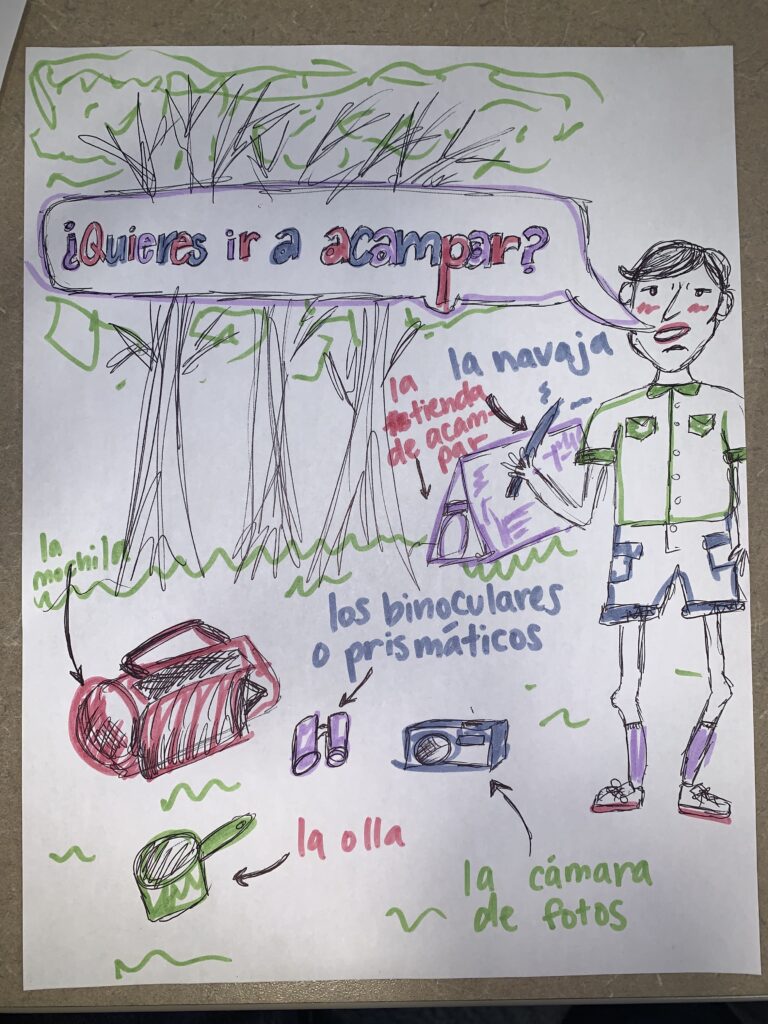Sketch Notes
I enjoyed today’s class immensely as I loved participating in the creative components. I appreciate the resources we learned about such as sketch notes, which I can see myself using in my future teaching and learning. Below I have given a photo of the sketch note I created:

The topic I chose was camping vocabulary in Spanish. This was a topic that interested me as I would like to travel and camp in Costa Rica in the future. Sketchnoting is a fun and engaging way to become immersed in a topic.
Infographics
Another resource we used this week is using Canva to make infographics. I think infographics are an excellent way to convey ideas in a simple and engaging image. When I was in tenth grade, I was first introduced to infographics and I remember having a breakdown the night before it was due because I found the medium so challenging. As I have had more practice, infographics are one of my favourite ways to present topics. Personally, I enjoy making something visually appealing now but I believe it is important to remember it can be challenging for students when they are starting out. Here is my infographic I created which relates to this week’s personal blog post:
SAMR Technique
In this week’s class we learned about the SAMR (Substitution, Augmentation, Modification, Redefinition) theory of technology adoption can be used to evaluate the impact of technologies in the classroom and determine their level of adoption. The theory categorizes the use of technology into four levels, each offering increasing levels of creativity and transformational impact:
- Substitution: At this level, technology is used to simply replace traditional tools and materials, but does not fundamentally change the task being performed. For example, using a word processing program instead of a typewriter.
- Augmentation: At this level, technology is used to enhance and improve traditional tasks, adding new features and capabilities. For example, using a multimedia presentation to augment a lecture.
- Modification: At this level, technology is used to transform the task itself, changing the way it is performed, but still retaining its original purpose. For example, using a collaborative online platform for group projects.
- Redefinition: At this level, technology is used to create entirely new forms of expression and communication, leading to fundamentally new ways of thinking and working. For example, using a virtual reality platform to simulate real-world experiences.
When evaluating technologies for use in the classroom, it is important to consider the level of technology adoption and the potential impact on student learning and engagement. Ideally, the technology should allow for tasks to be redefined, providing new opportunities for creativity and critical thinking. The SAMR theory can also help us, as future teachers, determine if the technology is simply a substitute or if it truly offers new opportunities for learning and growth.
Schetch Note Benefits & Application
As of right now, I hope to teach older middle school, perhaps grade six or seven. I believe sketch noting can greatly benefit learners in grade seven. Sketch noting can be especially beneficial for grade seven learners because it allows them to use their creativity and visual-spatial skills to understand and retain information in a unique and engaging way. Additionally, by using images and symbols, learners can make connections between abstract concepts and concrete examples, leading to deeper understanding and retention. Sketchnoting can also be used as an active learning tool, encouraging students to be more engaged and participatory in their learning. I think in older elementary, learners who do not excel in academics often are disengaged in activities but sketch noting could assist with that. Overall, the benefits of sketch noting can greatly enhance learning outcomes for grade seven learners.
That’s all for this week folk! Thanks for reading!